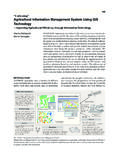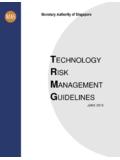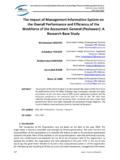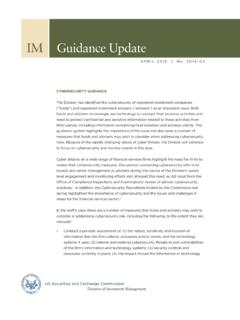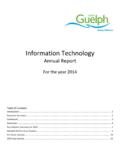Transcription of Return on Investment Analysis - Agile Insights
1 Return on Investment Analysis Mark Jeffery, Northwestern University Introduction The information Paradox Review of Basic Finance The Time Value of Money ROI, Internal Rate of Return (IRR), and Payback Period Calculating ROI for a technology Project Base Case Incorporating the technology Project Incremental Cash Flows and IRR Uncertainty, Risk, and ROI Uncertainty Sensitivity Analysis Project and technology Risks Monte Carlo Analysis Applied to ROI Executive Insights The Important Questions to Ask When Reviewing an ROI Analysis A Framework for Synchronizing technology Investments with Corporate Strategy Beyond ROI: Trends for the Future 2 2 ABSTRACT Return on Investment (ROI) Analysis is often an essential component of the management decision to invest in a new technology product or information technology (IT) project. This chapter reviews the basic concepts necessary for calculating ROI and applies these concepts to an example technology project.
2 Research on ROI for corporate investments in IT is also reviewed. A case example illustrates how a technology project s cash flows, combined with the initial Investment , can be used to calculate the ROI. The challenge in practice is to quantify the costs and benefits of the technology project. In addition, risk plays a significant role, because poor estimates and risk events are most often the drivers of poor ROI when technology projects are put into practice. Methods of incorporating uncertainty in assumptions and risk into an ROI Analysis are described. Finally, for the executive manager, important questions to ask when reviewing ROI Analysis are discussed, and the role of ROI Analysis in synchronizing technology investments with corporate strategy. For Investment -strategy synchronization, technology portfolio management is reviewed.
3 3 INTRODUCTION New technology projects must often show a good Return on Investment (ROI) in order to be funded. This chapter will give the reader the key concepts necessary to understand and calculate ROI for technology projects. In addition, the limitations of calculating ROI, best practices for incorporating uncertainty and risk into ROI Analysis , and the role ROI plays in synchronizing technology investments with corporate strategy will be discussed. What is ROI? One conceptual definition is that ROI is a project s net output (cost savings and/or new revenue that results from a project less the total project costs), divided by the project's total inputs (total costs), and expressed as a percentage. The inputs are all of the project costs such as hardware, software, programmers time, external consultants, and training.
4 Therefore if a project has an ROI of 100%, from this definition the cash benefits out of the project will be twice as great as the original Investment . (In the section Review of Basic Finance we will discuss how this definition of ROI, although qualitatively correct, does not accurately include the time value of money, and we will give a more accurate definition based upon internal rate of Return (IRR).) Should a manager invest a company's money in a technology project if it has a projected ROI of 100%? There are many factors one should consider when making an Investment decision. These factors include, but are not limited to those listed below: The assumptions underlying the costs of the project. The assumptions underlying the potential benefits. The ability to measure and quantify the costs and benefits. The risk that the technology may not be fully developed.
5 The risk that the project will not be completed on time and on budget and will not deliver the expected benefits. The strategic context of the firm; that is, does the project fit with the corporate strategy? The context of the project: that is, how does it fit within the portfolio of all technology investments made by the firm? The assumptions underlying the model and risks associated with the technology project are key drivers of uncertainty in any ROI Analysis . Awareness of these uncertainties and the impact of risks on ROI can significantly improve the likelihood of successful Investment decisions. The Return on Investment for corporate information technology (IT) investments has been the subject of considerable research in the last decade. (For reviews see Brynjolfsson & Hitt, 1998; Dehning & Richardson, 2002; Strassmann, 1990.) The most recent research suggests that investing in IT does on average produce significant returns (Brynjolfsson & Hitt, 1996).
6 See the next section, The information Paradox, for a discussion of this research. Jeffery and Leliveld (2004) surveyed CIOs of the Fortune 1000 companies: Of the 179 CIO respondents, 59% reported that their firms regularly calculated the ROI of IT projects prior to making an Investment decision, and 45% of respondents reported that ROI was an essential component of the decision-making process. ROI is therefore an important component of the information technology Investment decisions made in many large companies. However, an interesting observation is that only 25% of companies responding to the survey actually measured the realized ROI after a project was complete. ROI Analysis is therefore primarily used to justify an Investment decision before the Investment is made. Performing post-project Analysis provides valuable feedback to the Investment decision process to verify the validity of the original ROI Analysis , and the feedback improves ROI calculations in the future.
7 Feedback also enables the weeding out of underperforming projects. Full life-cycle ROI Analysis translates into better information to make better decisions, which in turn should impact the returns for the total corporate technology portfolio of investments. The total technology investments made by a firm can be thought of as a portfolio similar to a financial portfolio of stocks and options. Each technology Investment will have a different risk and Return (ROI) and, because capital is limited, selecting the optimal portfolio is a challenging management decision for any firm. The methodology for choosing and managing an optimal technology portfolio is called technology portfolio management . This process often includes the use of scorecards so that executive managers can rate projects on 4 4 multiple dimensions and ultimately rank projects in relative order of importance to the firm.
8 A typical scorecard will include several categories that help quantify the value of a project to the business and the risk of the project. Note that ROI is typically only one category on the scorecard and that several other factors may have equal or greater importance. In the Executive Insights section at the end of this chapter, an example of the technology portfolio management process at a major packaged food company and their score card used to rank technology projects are discussed. In the following section we will briefly review the research literature on returns on Investment for information technology and the related information paradox. The third section, Review of Basic Finance, is an introduction to the key finance concepts necessary to calculate ROI. Using these concepts, the ROI for a case example is calculated in the section Calculating ROI for a technology Project and a template is given that is applicable to any ROI calculation.
9 Uncertainty in assumptions and risk are important considerations, and the section Uncertainty, Risk, and ROI shows how to include these factors in the ROI Analysis . Specific risk factors for technology projects that may impact the ROI are also discussed. This section shows how sensitivity Analysis and Monte Carlo methods can be applied to ROI models; these are two powerful tools for understanding the range of possible ROI outcomes based upon the cost and revenue assumptions and the risks in the project. The last section, Executive Insights , gives some tools for oversight of technology Investment decisions specifically, questions to ask when reviewing an ROI Analysis and how ROI fits within a technology portfolio management framework for optimal technology Investment decisions are discussed. THE information PARADOX The question of how Investment in information technology impacts corporate productivity has been debated for almost a decade (for reviews see Brynjolfsson & Hitt, 1998; Dehning & Richardson, 2002; Strassmann, 1990).
10 Productivity is defined similarly to ROI in the introduction it is the amount of output produced per unit of input and although easy to define, it can be very difficult to measure for a firm (Brynjolfsson & Hitt, 1998). The output of a firm should include not just the number of products produced, or the number of software modules completed, but also the value created to customers such as product quality, timeliness, customization, convenience, variety, and other intangibles. One would expect that the productivity of the overall economy should increase over time, and this is indeed the case for the manufacturing sector, where the outputs are relatively easy to measure see Figure 1a. This productivity increase is not due to working harder because although working harder may increase labor output it also increases labor input.
